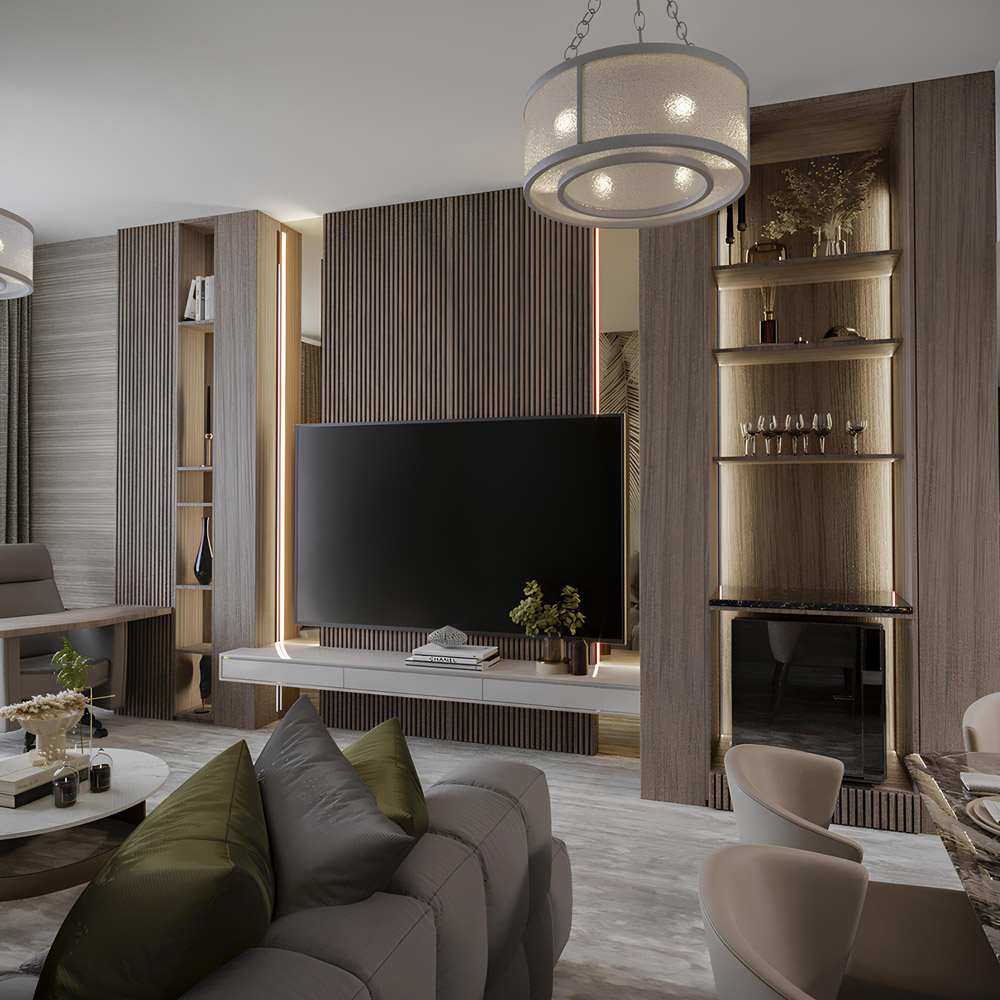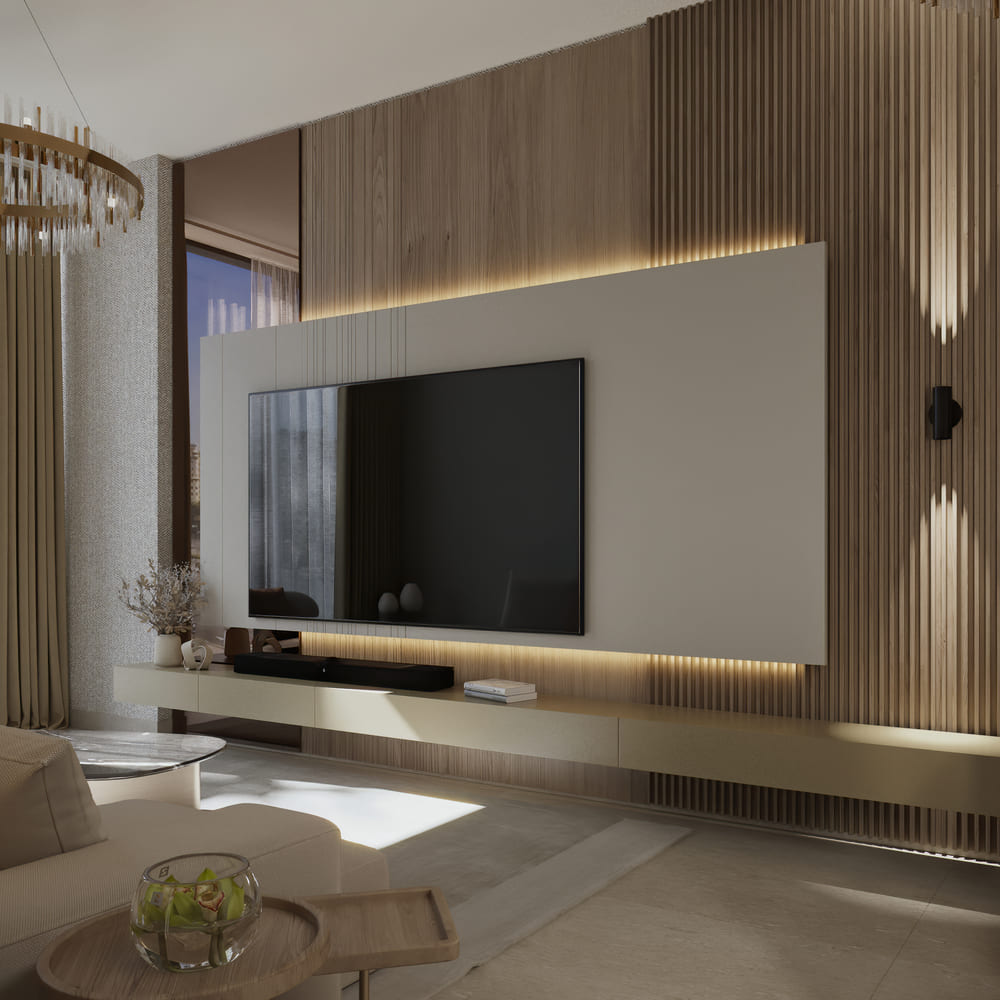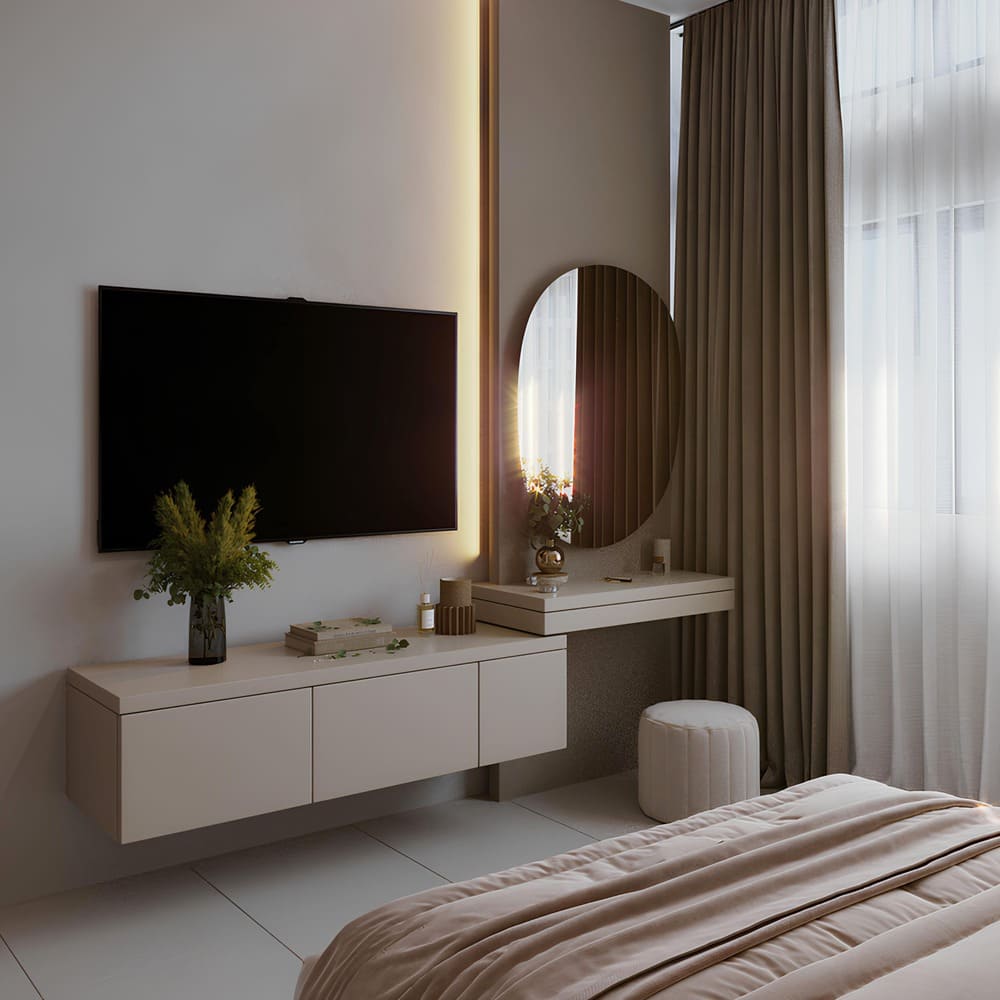In high-end Dubai interiors, the custom-made TV wall has evolved into far more than a place to mount a screen. It has become one of the most visually complex and expressive features within modern homes, serving as an architectural centerpiece that merges multiple design disciplines into a single statement. What makes these TV wall compositions in Dubai distinct is not only their material richness but the careful orchestration of rhythm, depth, and light that transform simple walls into curated installations. Let’s explore the deeper, often overlooked characteristics behind these designs.

1. Vertical Rhythm: Subtle Movement Without Visual Noise
A recurring visual device across these luxury interiors is the controlled use of vertical rhythm, created through finely spaced wooden slats. Rather than using uniform panels that might appear too flat, designers intentionally introduce micro-shadows with these slim vertical lines. Each narrow gap between slats creates delicate shadow play that shifts as the ambient light changes throughout the day. This slight movement provides a sense of animation to what would otherwise be a static wall.
In Dubai’s modern interiors, this vertical detailing also serves another purpose: it stretches the visual perception of height. In rooms where ceiling heights are already generous, the addition of these vertical elements exaggerates the proportions, making the space feel even taller and grander without adding any actual volume.
2. Floating Geometries: Weightlessness as a Luxury Statement
An advanced hallmark of Dubai’s modern custom TV walls is the consistent use of floating components—whether it’s the matte beige TV panel or the linear media console beneath it. Floating these elements slightly off the wall, combined with concealed lighting, generates an illusion of weightlessness. This sense of suspension conveys refinement and meticulous control over proportions.
In these designs, the distance between floating components and the back wall is always calculated with precision: too far, and it feels disconnected; too close, and it loses the shadow effect that amplifies depth. The careful balance contributes to a visually calming effect, as if each piece is perfectly positioned in a state of effortless equilibrium.

3. The Interaction of Technology and Architecture
One of the more subtle but highly intentional aspects is how the TV itself integrates with its surrounding panels. Instead of using bulky mounts or frames, such designs frequently position the TV nearly flush with the mounting surface, often on matte panels that visually absorb the screen’s presence. The result is a composition where the technology becomes embedded into the wall rather than sitting on top of it. This integration reflects a design philosophy where technology is treated as a visual material, not simply an appliance.
4. Narrow Lighting as Architectural Accent
The vertical linear LED strips used in many of Dubai interiors are not just lighting features—they are treated like structural accents. Their extremely narrow width and floor-to-ceiling placement slice through panel transitions, creating sharp lines of light that act almost like glowing seams in the architecture. This controlled use of illumination doesn’t flood the space with brightness but instead introduces a gentle glow that enhances verticality and offers visual hierarchy.
The lighting here serves both as boundary and connector: it separates different materials while visually linking upper and lower portions of the wall, keeping the composition unified.
5. Textural Layering: Quiet Contrasts Over High Drama
Unlike interiors that lean heavily on sharp contrasts or busy compositions, luxury TV walls employ layering of subtle tonal shifts and textures. For example, the combination of ribbed walnut panels beside matte beige surfaces allows for a sophisticated dialogue between warm wood and smooth lacquer. There’s no abrupt division—materials are blended through tonal harmony rather than harsh opposites.
Additionally, designers often introduce soft matte finishes that minimize reflectivity, allowing textures to define the visual interest rather than shine or gloss. Even the marble surfaces—whether on TV consoles or coffee tables—feature gentle veining rather than bold, high-contrast patterns. This restraint in texture selection avoids overwhelming the eye, contributing to a calm but deeply layered environment.
6. Integrated Display Niches: Functional Galleries
One creative observation often missed is how open shelving units within the TV wall are styled like curated mini-galleries. These niches, backed by subtly textured panels and illuminated from within, are designed with intentional spacing between objects—books, vases, abstract sculptures—allowing each item to occupy its own visual space. The lighting behind these objects removes hard shadows and makes them feel as if they’re floating, echoing the floating TV consoles.
These shelves go beyond mere storage; they become part of the overall architectural composition, turning functional shelving into part of the aesthetic rhythm.

7. Fabric Layers Framing the Composition
While the wall itself commands attention, the surrounding soft materials play an equally important role in softening the overall look. Full-height curtains, whether in muted olive, warm taupe, or blush tones, add fluidity and motion. Their gentle pleating introduces a vertical softness that echoes the hard vertical lines of the wall but through a completely different material language.
The color choices for these curtains are never purely neutral; there’s always a slight undertone—warm pink, green-gray, or subtle sand—that ties back to the palette of the wall panels, flooring, or furniture. These layers of fabric act like a visual cushion, framing the hard architectural elements with a softness that makes the space feel livable and intimate.
8. Organic Accents Balancing Precision
A less obvious but critical strategy in these designs is the introduction of gentle organic forms amidst the precise lines. Rounded coffee tables with ribbed bases, pleated accent chairs with shell-like backs, and softly curved floral arrangements subtly break the linear dominance of the TV wall. These organic touches prevent the composition from becoming too rigid, providing emotional warmth within the visual order.
Even lighting fixtures reflect this principle: chandeliers often feature layered discs or concentric wood rings, providing sculptural interest without sharp geometry. This balance of control and softness allows the design to feel both sophisticated and inviting.
9. Material Echo Across Surfaces
One of the most advanced design principles visible is the repetition of visual motifs across unrelated furniture pieces. For instance, the ribbing on wooden TV panels is echoed in the cylindrical coffee table base; the veining in marble consoles resonates with dining table surfaces. This repetition creates a visual coherence that ties the entire space together, even across different functional zones.
These repeating elements serve not only as aesthetic bridges but as visual clues that the space has been designed holistically, not in isolated parts.
10. Urban Luxury Context Framing the Interior
Finally, it’s important to note how these TV wall designs sit within Dubai’s broader luxury context. The large-format marble floors, expansive windows framing cityscapes, and carefully chosen reflective surfaces speak to an urban environment where both architecture and interior design are treated as part of the same luxury ecosystem. The TV wall becomes one of many surfaces that catch and reflect the city’s light, contributing to an atmosphere of high-end metropolitan calm.
In summary
the luxury modern custom-made TV wall design in Dubai is not merely about materials or technology—it is about a complex choreography of vertical rhythm, floating geometries, carefully layered textures, integrated lighting accents, and subtle organic touches that balance precision with softness. These walls do not scream for attention but instead create an atmosphere of controlled sophistication, where every visual element speaks to intentional restraint and quiet richness.
